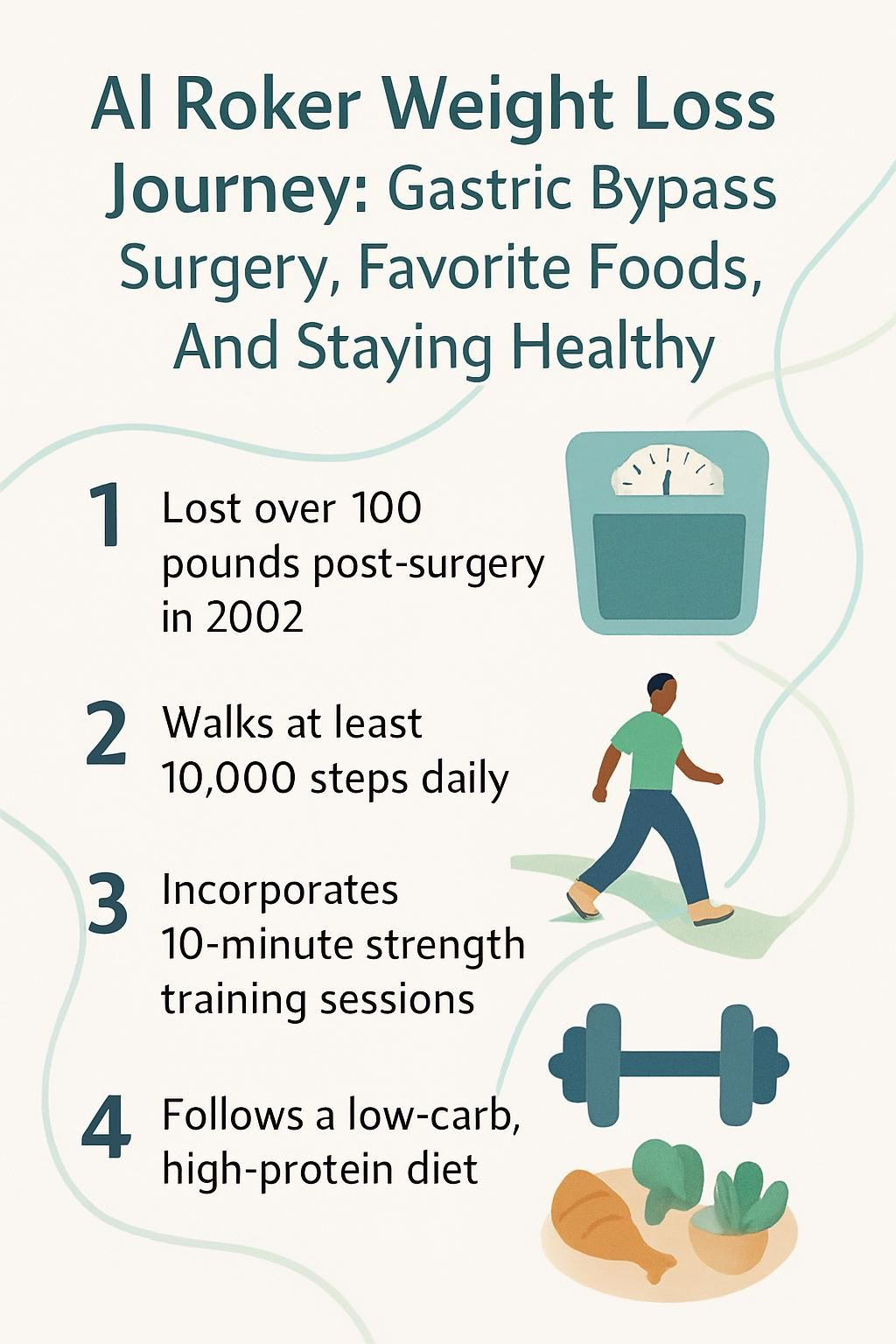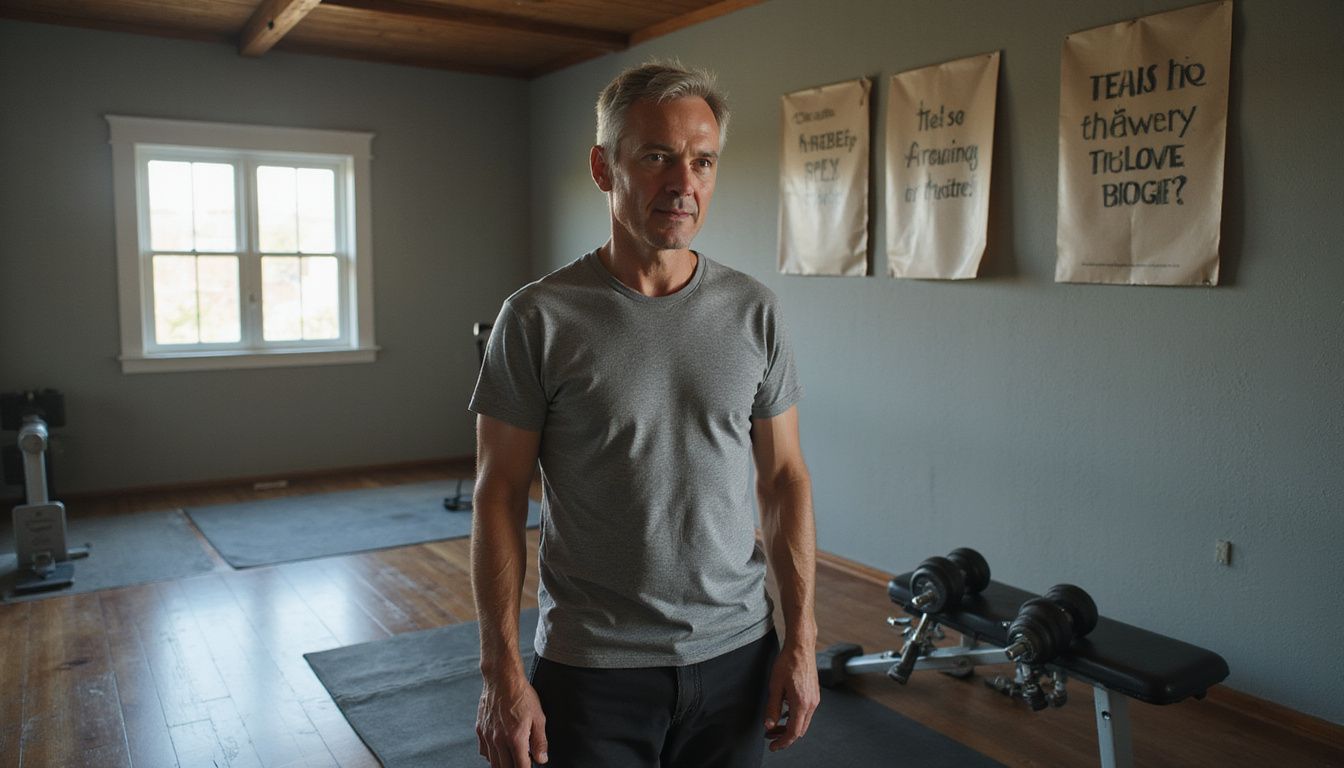Al Roker Weight Loss Journey: Gastric Bypass Surgery, Favorite Foods, And Staying Healthy
Our Nutrition Assistant AI Suite will transform your body. You will lose fat, get toned, and build muscle. Gain confidence and optimal health.
If you struggle to maintain weight or fear regaining after a diet, you are not alone. Al Roker shows sustained results are possible. His weight loss journey, including gastric bypass surgery, has helped him keep off about 100 pounds for more than two decades.
In this guide, you will see how Al combined surgery, favorite foods like baked potatoes and vanilla ice cream, and steady routines such as daily walking, treadmill sessions, and light strength work. These ideas translate into simple steps you can use.
Keep reading to learn what supports long-term success and daily wellness without rigid rules.
Key Takeaways
- Al Roker lost over 100 pounds after gastric bypass surgery in 2002 and has maintained the loss for more than 20 years.
- He favors a low-carb, high-protein pattern, limits processed foods, and eats mindfully, including no phones at the table.
- Daily movement anchors his plan, with at least 10,000 steps, short strength sessions, and quick “walking snacks.”
- Support from family, medical professionals, and a large wellness community helped with motivation and accountability.
- Major steps such as surgery or weight loss drugs like Ozempic require medical guidance for safety and long-term success.

Al Roker’s Weight Loss Journey

Al Roker faced weight challenges for years, which pushed him to seek a lasting fix. He chose a medical path, then built daily habits that protected the loss over time.
What weight challenges did Al Roker face before 2002?
Before surgery, Al struggled with cycles of dieting and regaining. His weight reached about 340 pounds at times, and portion control felt hard to manage.
He spoke about mindless eating, such as finishing a pint of ice cream while distracted. That relationship with food made maintenance difficult and raised health concerns, which led him to seek expert care.
I struggled for years with my weight, trying every diet and program but nothing lasted, Roker said in an interview.
Many readers know this pattern. Cravings, setbacks, and frustration can push you toward bigger changes and a more structured health journey.
Why did Al Roker choose gastric bypass surgery?
After many plans failed to last, he wanted a solution that could create a strong, sustainable change. In 2002, a team of clinicians recommended gastric bypass surgery for his situation.
The goal was not a quick fix. It was a tool that, paired with daily habits, could support long-term health and an active lifestyle on the Today show. Family support, including from Deborah Roberts, helped him commit.
How did Al Roker lose 100 pounds after surgery?
The procedure limited how much he could eat and affected hunger hormones, which made weight control easier. He then built a routine around a low-carb, high-protein diet and whole foods like fish, yogurt, vegetables such as spinach, and healthy fats.
Movement mattered as much as meals. He aimed for 10,000 steps a day, used the treadmill at home, lifted weights for at least 10 minutes, and took short walks during the day to break up sitting.
He credits these healthy habits for steady results, even through recent health challenges such as prostate cancer treatment. Sleep, stress control, and consistent meal planning kept his progress strong years later.
The Role of Gastric Bypass Surgery
Surgery gave Al Roker a fresh start, but habit change kept it going. Many people weigh this option alongside traditional dieting or newer weight loss drugs.
How does gastric bypass surgery work?
Gastric bypass surgery reduces stomach size and reroutes part of the small intestine. This limits how much you can eat and how many calories and nutrients your body absorbs. A specialist team evaluates eligibility and provides nutrition rules after surgery.
It is intended for people with obesity or obesity-related conditions, such as type 2 diabetes, when other methods have not worked. Follow-up care with a dietitian and doctor is essential.
- Typical excess weight loss: about 60 to 80 percent within 1 to 2 years, based on reports from the American Society for Metabolic and Bariatric Surgery.
- Common health gains: better blood sugar control, lower blood pressure, and improved sleep apnea, noted by the National Institutes of Health.
- Risks exist, including nutrient gaps and surgical complications, which require long-term medical follow-up.
This information is educational. It is not medical advice. Discuss your risks and benefits with your healthcare professional.
What was Al Roker’s experience with gastric bypass surgery?
He had gastric bypass surgery in 2002 and worked closely with his medical team during recovery. The weight dropped quickly, but the real focus became maintenance.
He shared updates on social platforms and built a community of nearly a million newsletter readers around wellness, daily walking, and simple kitchen habits. Public support and accountability helped him keep going.
He also discussed hard days, which showed how steady commitment matters after any major health change.
What challenges did Al Roker face after the surgery?
Portion control remained a challenge, even with a smaller stomach. Certain foods did not sit well, so he had to avoid heavy or highly processed items.
Long-term nutrition checks were important. He worked with a dietitian, faced health issues including blood clots in 2022, and had his gallbladder removed. More walking and strength work became part of his daily rhythm on the Today show.
Balancing a healthy diet with regular movement helped prevent regain. Next, see how a simple eating pattern supports life after surgery.
Lifestyle Changes Post-Surgery
Life after surgery calls for smart food choices and steady movement. Small, repeatable actions make the difference.
Following a low-carb, high-protein diet
Al Roker follows a low-carb, high-protein pattern to protect his results. Breakfast often includes protein-rich yogurt. Lunch might be sushi or sashimi such as tuna or salmon, which provide protein and healthy fats from fish. Dinner is usually chicken thighs and vegetables. Peanut butter serves as a filling snack.
- Protein target per meal: 20 to 30 grams, a range many dietitians suggest for satiety and muscle support.
- Smart picks: fish, eggs, Greek yogurt, lean poultry, beans, and tofu.
- Fiber focus: leafy greens, roasted vegetables, and berries for fullness and digestive health.
One simple tweak, such as starting the day with yogurt and fruit, can steady hunger until lunch. That small win builds momentum for the rest of the day.
Cutting out processed foods
Reducing packaged snacks and fast food helped him maintain weight. Cooking at home lets you control salt, sugar, and added oils. He often pan-sears or roasts with olive oil, then adds spices for flavor.
Fresh swaps make a clear difference. Try sheet-pan dinners with lean protein and roasted vegetables. Use nuts or fruit instead of chips or cookies for snacks. This approach supports lower inflammation and steadier energy.
Managing portion sizes effectively
Simple rules support portion control. A no-phone policy at meals reduces distraction and helps you notice fullness. Al once finished a pint of ice cream in one sitting. Now he practices moderation and stops earlier.
Mindful bites, slower chewing, and smaller plates can help you right-size portions without counting every calorie. To build consistency, pick one or two tactics and use them at most meals.
Al Roker’s Exercise Routine
Movement acts like a savings plan for your health, small deposits add up.
How does weight training fit into Al Roker’s daily routine?
He includes 10 minutes of weight training most mornings, often with guidance from the Start TODAY fitness app. Short, regular sessions build strength for daily tasks and support healthy aging.
Experts recommend strength training for older adults to support bones, muscles, and joint mobility. A quick routine before a walk can set the tone for the entire day.
Why does Al Roker walk 10,000 steps a day?
He uses 10,000 steps as a clear daily goal. Walking supports heart health, lowers inflammation, and helps keep weight stable according to public health research from groups like the CDC.
Steps can come from a commute, work breaks, or evening loops in the neighborhood. In warm weather, he takes 30 to 45 minute walks through Central Park.
Walking is accessible. No special gear is required, and it pairs well with weight training and mindful eating.
What are “walking snacks” and how do they help?
Walking snacks are brief walks you sprinkle into your day. Al fits them in at 30 Rockefeller Center, using loops around the building or walking desks in office spaces.
Short strolls break up sitting, which supports energy, focus, and blood sugar control. Comfortable, cushioned shoes make it easy to hit step goals on busy days. These mini-walks were a key part of his Start Today wellness plan.
Favorite Foods in Al Roker’s Diet
Food is fuel and pleasure. The right choices can lower inflammation and power your day.
What anti-inflammatory foods does Al Roker prefer?
Breakfast might include yogurt and bananas, which offer nutrients that support lower inflammation. He sips mint-ginger iced tea during busy days, and ginger contains compounds linked with anti-inflammatory effects in studies.
For lunch, tuna or salmon provide omega-3 fats, known to reduce markers of chronic inflammation. Peanut butter is a satisfying snack with healthy fats. Roasted vegetables show up often for fiber and antioxidants that support digestion and recovery after long walks or fitness challenges.
How does Al Roker prepare meals at home?
Home cooking keeps ingredients simple and flavors bright. As a cookbook author, he favors pan-seared fish or chicken with olive oil, plus roasted vegetables. Sheet-pan dinners save time and simplify cleanup.
He skips most packaged foods and leans on herbs like mint or ginger for flavor. I tried this approach in my own kitchen. Adding more herbs made meals taste better and reduced my need for extra salt.
What are Al Roker’s go-to breakfast options and snacks?
He often starts with yogurt and granola plus a banana for protein, fiber, and steady energy. Cold brew coffee helps with focus, especially on early mornings.
Snacks center on protein and healthy fats, such as a spoonful of peanut butter or a small handful of nuts. Hydration supports mood and concentration, so keep water close by throughout the day.
Staying Motivated and Overcoming Setbacks
Progress builds from patience, not perfection. A few simple habits, repeated daily, carry you forward.
Why are patience and consistency important for weight loss?
Healthy weight loss takes time. Many clinicians suggest losing one to two pounds per week for safety and better maintenance. Al Roker’s journey took years, and the daily choices mattered more than any single week.
Setbacks happen. They do not erase your effort. Mindful eating and routine exercise reduce slips and make it easier to return to your plan.
How can building a support system aid your journey?
Support reduces isolation and keeps you accountable. Al relied on family, clinicians, and a large community of readers for steady encouragement and practical tips.
Share goals with people who want to see you succeed. Community groups and wellness apps offer check-ins, reminders, and recipes. Device-free meals with a partner, like Al and his wife practice, can strengthen mindful eating.
How does focusing on long-term goals help maintain motivation?
Long-term goals give daily choices a clear purpose. Al thinks about staying strong as he ages and being able to carry his granddaughter.
Research shows realistic, meaningful goals help people stick with habits for years. Sustained weight maintenance becomes more likely when your goals reflect the life you want.
Tips for Others on Their Weight Loss Journey
Expert support, a practical plan, and honest self-checks help you build a path you can keep.
Why should you consult healthcare professionals before starting?
Consulting your medical team creates a safe starting point. Al Roker worked with clinicians before his gastric bypass surgery in 2002, which helped him choose the right option.
Doctors and dietitians can review your history, screen for risks, and suggest a plan that fits your needs. Regular checkups catch problems early and increase your chances of safe, lasting results.
Educational note: This article does not replace medical advice. Always speak with your licensed clinician.
How do you find a weight loss plan that fits your needs?
Pick a plan that matches your taste, schedule, and health goals. Al reminds people that every path is personal, including choices about weight loss drugs like Ozempic.
Choose changes you can stick with, such as whole grains instead of refined carbs or grilled fish instead of fried meals. Tools like the Start Today Wellness and Fitness App offer dietitian-approved meal plans and activity ideas that suit different lifestyles.
Sustainability beats perfection. A plan you enjoy is the one you will follow.
How can you balance diet, exercise, and mental health?
Start with small actions. Take the stairs, walk to transit, or add a 10-minute strength set. Build meals around produce and protein, and use a no-phones-at-the-table rule to support mindful eating.
Daily walking or step goals boost mood and focus. Hydrate well and protect your sleep since both affect appetite, stress, and performance. In my experience, short walking snacks during breaks lift energy for the rest of the day.
Conclusion
Al Roker’s story shows how a medical tool, healthy eating, and daily movement can work together. A low-carb, high-protein pattern, simple home cooking, and regular walking helped him maintain his 100-pound weight loss.
Moderation, not deprivation, kept favorite foods in the picture. Focus on habits that fit your life, such as weight training a few minutes a day, using the Start Today app, or planning easy meals. Set goals that matter to you and take consistent steps. That is how you stay healthy and keep moving forward on your own weight loss journey.
FAQs
1. What weight loss method did Al Roker use and how effective is gastric bypass surgery?
Al Roker chose gastric bypass surgery to lose weight. This procedure reduces the size of the stomach, which limits food intake and helps with weight loss. Studies from the National Institutes of Health show that people often lose 60 to 80 percent of their excess weight within two years after surgery. The procedure also lowers the risk of diabetes and heart disease.
2. What are some favorite foods Al Roker enjoys while staying healthy?
Al Roker includes lean proteins, vegetables, and whole grains in his meals. He has shared that he likes grilled chicken, roasted vegetables, and salads with olive oil dressing. These foods provide nutrients without adding too many calories or unhealthy fats.
3. How does Al Roker maintain his health after gastric bypass surgery?
He follows a balanced diet plan and exercises regularly to keep the weight off. He tracks his food intake and avoids high-sugar snacks or processed foods. Regular check-ups with healthcare professionals help him monitor progress and address any concerns early.
4. What challenges did Al Roker face during his weight loss journey?
Al Roker experienced both physical changes and emotional adjustments after surgery. He had to learn new eating habits since overeating could cause discomfort or complications. Support from family members helped him stay motivated throughout recovery and long-term maintenance.
Summary:
Al Roker’s experience shows that gastric bypass surgery can lead to significant weight loss when combined with healthy eating habits and regular exercise. Choosing nutrient-rich foods like lean meats and vegetables supports long-term success while ongoing support helps manage new lifestyle changes effectively.







